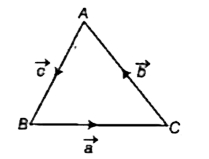It the vectors →a,→b and →c form the sides −−→BC,−−→CA and −−→AB respectively of a triangle ABC, then write the value of →a×→c+→b×→c.
 Solution in Odia
Solution in Odia
Step by step video & image solution for It the vectors vec(a), vec(b) and vec(c) form the sides vec(BC), vec(CA) and vec(AB) respectively of a triangle ABC, then write the value of vec(a) xx vec(c) + vec(b) xx vec(c). by Maths experts to help you in doubts & scoring excellent marks in Class 12 exams.
Updated on:21/07/2023Topper's Solved these Questions
- VECTOR ALGEBRA BOOK - ARIHANT PUBLICATIONCHAPTER - VECTOR ALGEBRA EXERCISE - Questions for Practice (Part I Basic Concepts) Very Short Answer Type Questions
15 Videos
- VECTOR ALGEBRA BOOK - ARIHANT PUBLICATIONCHAPTER - VECTOR ALGEBRA EXERCISE - Questions for Practice (Part I Basic Concepts) Short Answer Type Questions
10 Videos
- THREE-DIMENSIONAL GEOMETRYBOOK - ARIHANT PUBLICATIONCHAPTER - THREE-DIMENSIONAL GEOMETRYEXERCISE - Chapter Practice
34 Videos
Similar Questions
If A, B, P, Q and R are the five points in a plane, then show that the sum of the vectors
−−→AP,−−→AQ,−−→AR,−−→PB,−−→QB and −−→RB is 3−−→AB.
View SolutionIf →a and →b are the position vectors of →A and →B respectively, then find the position vector of a point →C and −−→BA produced such that −−→BC=1.5−−→BA. Also, it is shown by graphically.
View SolutionThe x-coordinate of a point on the line joining the points P(2,2,1) and Q(5,1,−2) is 4. Find its z-coordinate.
View SolutionIf vec a, vec b, vec c are three vectors such that | vec b | = | vec c | then {(vec a + vec b) xx (vec a + vec c)} xx {(vec b xxvec c)} * (vec b + vec c) =
View Solutionयदि →a,→b,→c तीन सदिश इस प्रकार हैं कि →a×→b=→c,→b×→c=→a तथा →c×→a=→b दिखाएँ कि →a,→b,→c इकाई सदिशों का एक दक्षिणावर्ती समकोणिक त्रिक बनाते हैं |
View SolutionLet →a,→b,→c be the positions vectors of the vertices of a triangle , prove that the area of the triangle is 12∣∣→a×→b+→b×→c+→c×→a∣∣
View SolutionIf →a,→b and →c are mutually perpendicular unit vectors and →a×→b=→c, show that →b=→c×→a and →a=→b×→c.
View SolutionFor any three vectors →a,→b,→c , show that →a×(→b+→c)+→b×(→c+→a)+→c×(→a+→b)=0
View SolutionIf →a, →b, →c are three vectors such that →a.→b=→a. →c and →a × →b=→a × →c, →a ≠0 , then show that →b=→c .
View SolutionIf →A,→Band→C are vectors such that ∣∣→B∣∣−∣∣→C∣∣. Prove that [(→A+→B)×(→A+→C)]×(→B+→C).(→B+→C)=0
View Solutionयदि →a,=→b×→c[→a→b→c]'→b'=→c×→a[→a→b→c]'→c'=→a×→b[→a→b→c] है, तब प्रदर्शित कीजिए कि →a×→a'+→b×→b'+→c×→c'=0 होगा, जहाँ →a,→b,→c असमतलीय सदिश है |
View SolutionIf the vectors →a,→b,→c form the sides −−→BC,−−→CA,−−→AB respectively of triangle ABC then show that →a×→b=→b×→c=→c×→a.
View SolutionIf the vectors →a,→b,→c are represents the sides −−→BC,−−→CAand−−→AB respectivley of triangle ABC, then
View SolutionIf →a,→b,→c are position vectors of the vertices of the triangle ABC, then ∣∣(→a−→c)×(→b−→a)∣∣(→c−→a).(→b−→a) is equal to
View SolutionIf →a,→band→c are three vectors such that →a×→b=→cand→b×→c=→a, prove that →a,→b,→c are mutually perpendicular and ∣∣→b∣∣=1and|→c|=|→a|.
View Solution
